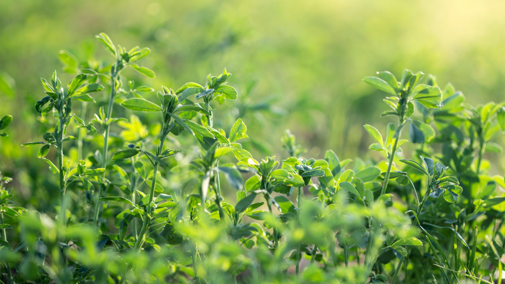Fall Planting Alfalfa
Alfalfa can be successfully seeded in the fall or spring depending on moisture conditions, weed populations, and timing. Fall seeding usually begins in late August or early September to allow at least four to six weeks of growth before the first killing frost. Prior to the three to five trifoliate leaves development stages, temperatures below 27°F can kill young alfalfa seedlings.
Although it may be tempting to drill or broadcast more seeds into open spaces in thin stands, remember that live alfalfa roots emit an ethylene chemical toxin which impedes new alfalfa growth. This “autotoxicity” weakens or kills any new alfalfa plants and accumulates in soil over time. Therefore, it is better to drill into new fields versus seeding where previous older alfalfa plants have been grown within the past one to two years.
Once established, alfalfa is a perennial competing well with weeds, especially in the fall versus spring seeding. If herbicide-resistant weeds are currently growing on fields, then light tillage may be needed to control weeds while creating a firm drilling seedbed. Also, combining light tillage plus herbicide may provide improved seedling establishment. Since new alfalfa seedlings are very susceptible to herbicide injury, follow any chemical label restrictions. New alfalfa plants must reach two to four trifoliated leaf development before herbicides are applied, and 2,4-D usage is not recommended.
When selecting alfalfa seed, select varieties with fall dormancy ratings of 3 to 5. Also, Round-up Ready or glyphosate-tolerant alfalfa varieties may provide more flexibility for controlling weeds later.
Target seeding ¼- to ½-inch depth in the fine-textured soils and ¾-inch depth in sandy soils. Seedlings placed too shallow will dry out rapidly and die due to poor roots, while seeds planted more than one inch deep may be unable to emerge after germinating. Further fall establishment guidelines are outlined in the UNL Extension NebGuide “Seeding Alfalfa” (G2247).
Winter Annual Forages
Are you thinking about seeding a winter annual cereal grain to have some forage next spring? The possible choices are wheat, rye or triticale, but which of these small grains should you seed this fall? Let’s look at some of their characteristics to help you select.
Cereal rye is your best choice for the earliest grazing possible. Because it’s early, it also may be the best match for double cropping. Rye can provide some fall forage, if planted early. Rye also may be the most reliable when planted under stressful conditions, but it has some drawbacks. It turns stemmy and matures much earlier than wheat or triticale, losing feed value and palatability earlier in the spring. Plus, wheat grain producers don’t want it contaminating fields next year.
Triticale holds onto its feed value best into late spring. This makes it well suited for hay and silage, or for stretching grazing well into June if you don’t mind starting two or three weeks later compared to rye. But triticale tends to be a bit more susceptible to winter injury.
Winter wheat has been the small grain of choice for winter and spring grazing in the southern Plains where higher winter temperatures allow growth to continue, although slowly. Up here where wheat goes dormant, though, its carrying capacity is not as high as triticale or rye. But it is top quality before stems develop. And it’s the clear choice if you want the double use as early pasture and then for grain.
So there it is. Rye for early pasture, triticale for hay, silage, or later grazing, and wheat for grazing plus grain. You may have other factors affecting your choice, but in general, these guidelines work well.

